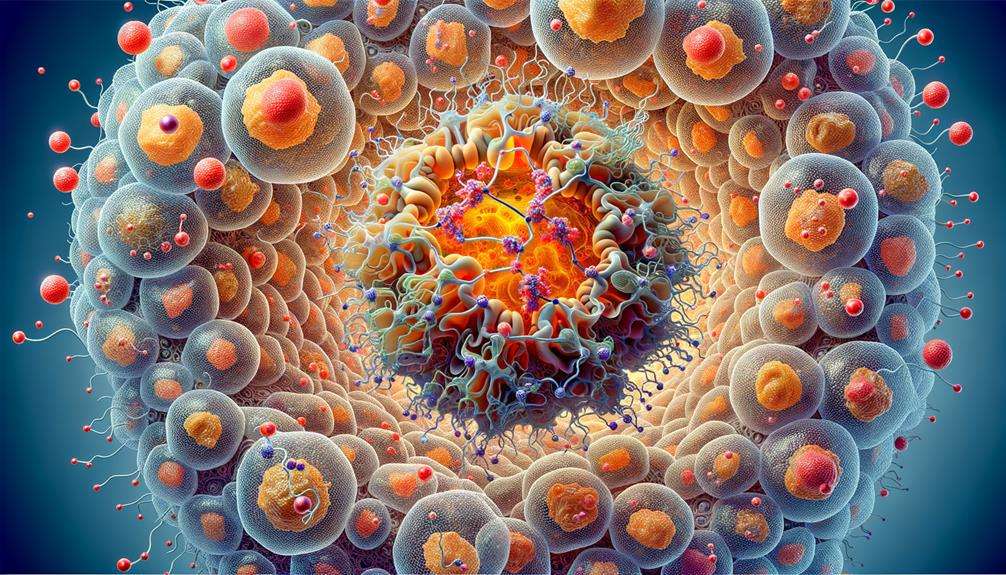Understanding Phospholipids: Their Role in Cell Membranes and Health Benefits
Phospholipids are crucial to your health; they form the protective structure of your cell membranes and regulate molecular traffic. They’re pivotal in cell communication and guarantee your cells function at their best. Additionally, they support your brain health, help absorb vitamins, and maintain liver function. They even play a part in reducing inflammation. Interestingly, phospholipids are also being explored for potential roles in disease management and personalized medicine. Stay tuned, there’s a wealth of fascinating knowledge waiting to be discovered about understanding phospholipids, these essential molecules.
Introduction to Phospholipids

You’ve probably heard of phospholipids, but do you really know what they are?
They’re a key component of cellular structures, performing essential roles you mightn’t be aware of.
Let’s get to know them better, starting with their definition and role in cell formation.
What Are Phospholipids?
Let’s explore the world of phospholipids, an essential class of lipids that serve as the building blocks of all cell membranes. Understanding these fascinating molecules will help us appreciate our bodies’ intricate workings, fostering a sense of belonging to the larger biological world.
Phospholipids consist of:
- A glycerol molecule, the backbone binding everything together
- Two fatty acids, which provide energy and play a crucial role in lipid metabolism
- A phosphate group, adding to the molecule’s amphiphilic properties
These amphiphilic properties allow phospholipids to form protective barriers in cell membranes. This unique role ensures that essential nutrients can enter our cells while keeping harmful substances out. So, when you think about your health, remember the humble phospholipids working tirelessly to keep you well.
The Role of Phospholipids in Cellular Structures
Having established how phospholipids form, it’s fascinating to see their role in creating intricate cellular structures. They’re the building blocks of the cell membrane structure.
Specifically, phosphatidylcholine, a type of phospholipid, plays an essential part. It helps maintain membrane fluidity, important for cellular permeability – controlling what gets in and out of the cell. This fluidity is greatly influenced by the types of fatty acids present. Polyunsaturated fatty acids, for instance, increase flexibility and permeability.
Functional Implications of Phospholipids in Biological Systems
You might wonder, ‘What’s the big deal about phospholipids?’
Well, beyond their role in creating cell membranes, they’re key players in cell metabolism and can even influence disease management.
We’ll explore these intriguing functions and their critical importance to your body’s health.
Understanding Phospholipids: Their Role in Cell Membranes and Health Benefits
Structural and Metabolic Roles in Cells
Delving further into the world of phospholipids, it’s crucial to understand their varied structural and metabolic roles in our cells, particularly as they’re key components in biological systems. These intricate molecules, with their glycerol backbone and omega fatty acids, are fundamental to the integrity of our cell membranes and the smooth running of lipid metabolism.
Phospholipids, as the unsung heroes in our cells, keep our cell membranes healthy and fluid. They play a pivotal role in lipid metabolism, ensuring our cells function as they should. Their unique structure, including the glycerol backbone and omega fatty acids, is a reflection of nature’s brilliance.
Phospholipids in Disease Management
Let’s explore how phospholipids, these essential components of our cells, play a pivotal role in disease management. You’re part of a community dedicated to understanding the importance of these bioactive lipids.
Phospholipids are integral to forming lipoproteins, which carry fats and cholesterol through your body. They also produce eicosanoids, active lipid molecules with key roles in inflammation and immunity. Some eicosanoids encourage inflammation, but the body can produce anti-inflammatory lipids as well. These can act as natural cyclooxygenase inhibitors, reducing pain and swelling.
There’s a growing interest in how phospholipids can contribute to tumor inhibition lipids, potentially opening new avenues in cancer treatment. So, you see, these tiny components have monumental health implications.
Phospholipids and the Endocannabinoid System
You’ve learned how phospholipids play a key role in the structure and function of cells.
Now, let’s explore how they intersect with the endocannabinoid system.
We’ll discuss how the synthesis of endocannabinoids and omega-3 fatty acids contribute to endocannabinoid function.
Exploring the Intersection of Myelin, Phospholipids, and Cannabinoids in MCT Oil
Synthesis of Endocannabinoids
Understanding the synthesis of endocannabinoids requires a grasp of how omega-6 and omega-3 fatty acids, integral components of phospholipids, are involved in this process. These fatty acids lay the groundwork for the production and functioning of endocannabinoids. Engaging with cannabinoid receptors, endocannabinoids help maintain balance within your body’s systems.
Your body’s wellbeing depends on this delicate balance, which is influenced largely by what you consume.
Omega-6 and omega-3 fatty acids, found in good-quality sources like fish, flaxseeds, and hemp, can support your endocannabinoid system.
Omega-3 Fatty Acids and Endocannabinoid Function
Delving into the relationship between Omega-3 fatty acids and the endocannabinoid system, it’s important to recognize how these fatty acids, key components of phospholipids, play a pivotal role in shifting your body’s endocannabinoid balance.
Omega-3s, particularly DHA-EA and EPA-EA, aren’t just part of your diet, they’re essential to your wellbeing. They contribute to the formation of endocannabinoids, which help maintain homeostasis in your body. By consuming a diet rich in Omega-3s, you’re not only supporting your overall health but also fostering a balanced endocannabinoid function.
Essentially, phospholipids and Omega-3s aren’t just words on a nutrition label; they’re crucial components that help you feel your best. Understanding their function brings you one step closer to achieving optimal health.
Learn about the synergistic benefits of Omega-3 and CBD oil
Advanced Study of Phospholipids
Now, let’s move on to explore the advanced study of phospholipids.
You’ll find that analytical techniques are essential for examining these important molecules.
Additionally, you’ll learn how synthetic phospholipid bilayers serve as vital models in research.
Analytical Techniques for Phospholipid Examination
In order to fully grasp the nature of phospholipids, it’s important to explore analytical techniques such as Capillary Gas Chromatography (CGC), Supercritical Fluid Chromatography (SFC), High-Performance Liquid Chromatography (HPLC), and Micellar Electrokinetic Chromatography (MEKC). These techniques let you investigate the world of amphiphilic molecules, revealing how their hydrophobic interactions shape the bilayer membrane. You’ll understand why intact phospholipid analysis is crucial, and the role synthetic bilayer vesicles play in this process.
- The sense of accomplishment when you unravel these complex structures
- The thrill of discovery as you understand their crucial roles
- The feeling of belonging to a community of knowledge seekers, exploring the building blocks of life
Synthetic Phospholipid Bilayers as Research Models
When you dive deeper into the advanced study of phospholipids, you’ll encounter synthetic phospholipid bilayers, essential research models in understanding membrane dynamics and protein interactions. These models are crucial, much like the hydrophilic tails in phospholipids that attract water and help maintain the cell’s environment.
In your journey, you’ll learn about multilamellar and small bilayer vesicle applications, fundamental to the study of these dynamics. You’ll discover how this knowledge can be applied to products like the Genesis Blend full spectrum CBD oil. Such products enhance our understanding of how natural substances interact with our body at a cellular level.
This exploration isn’t just about knowledge, but also about belonging to a community that values health, science, and natural solutions.
Conclusion
So, you’ve come a long way in your understanding of phospholipids.
As we wrap up, let’s ponder on the future prospects in phospholipid research.
There’s a world of possibilities waiting to be explored, and every discovery could reveal new dimensions in cellular health and beyond.
Future Prospects in Phospholipid Research
Looking ahead, you’ll find that the field of phospholipid research holds promising prospects, particularly in relation to health applications and endocannabinoid modulation. This means you could become part of a community that’s at the forefront of health and science.
- Imagine the thrill of contributing to the development of new treatments and preventions.
- Picture your work having a direct impact on improving people’s quality of life.
- Think about the satisfaction of being part of a scientific breakthrough.
The future of phospholipid research is exciting, and it’s right there, waiting for you to step in. So why not take that step, and become part of something bigger than yourself?
Frequently Asked Questions
What Are the Different Types of Phospholipids Found in the Human Body?
You’re curious about the types of phospholipids in the human body, aren’t you? Well, there’s quite a variety! Phosphatidylcholine, Phosphatidylethanolamine, Phosphatidylinositol, and Phosphatidylserine are some examples.
Each plays a unique role in maintaining your body’s health and functionality. Remember, understanding these tiny powerhouses can help you make better health decisions.
Isn’t it amazing how the microscopic world influences our daily lives?
How Do Phospholipids Contribute to Maintaining Overall Health?
Imagine your body as a bustling city. Phospholipids are like the city’s gates, controlling what gets in and out of your cells. They help keep your cells functioning well, which is essential for your overall health.
They’re also involved in important functions like signaling pathways, which is like the city’s communication system. So, maintaining healthy phospholipid levels is like ensuring your city’s gates and communication systems are in top shape.
What Is the Relationship Between Phospholipids and the Endocannabinoid System?
You’re probably wondering how phospholipids and the endocannabinoid system connect.
Well, phospholipids form your cell membranes, including those of your endocannabinoid system. They help maintain a balance in your body, much like the cannabinoids do.
When you consume quality fats, such as those in Genesis Blend CBD oil and our Omega-3 Soft gels capsule, you’re supporting the function of both these systems.
How Do CBD Products, Like Those From Bluegrass Hemp Oil, Affect Phospholipids?
You’re wondering how CBD products from Bluegrass Hemp Oil might affect phospholipids, right?
Well, their natural extraction methods preserve the integrity of fatty acids, which are similar to those in phospholipids. This means their CBD products can support your body’s endocannabinoid system effectively, contributing to your overall wellness.
It’s a great way for you to take care of your health naturally and holistically!
What Are the Implications of Phospholipid Research on the Development of Future Therapies?
You’re part of something big! Phospholipid research could revolutionize future therapies. It’s fascinating how these tiny molecules in our cell membranes can impact our health.
As research progresses, we’ll likely see new treatments for diseases, improved drug delivery systems, and overall enhanced health. So, you’re not just learning about phospholipids, you’re on the cutting edge of understanding our bodies and health.
It’s an exciting time, isn’t it?
Conclusion

So, you see, phospholipids aren’t just essential for your body’s health and balance.
Imagine you’re a professional athlete. How you perform could hinge on your cellular health, and therefore, your phospholipid levels.
By understanding and maintaining these microscopic heroes, you’re not just improving your cellular health, you’re optimizing your entire body’s performance.
Don’t underestimate the power of phospholipids! Your cells, and you, will be better for it.
Discover the source of premium Full Spectrum CBD by visiting Kentucky Cannabis Company, the proud parent company of Bluegrass Hemp Oil.
